Given the very large number of active theatres in Germany, their extensive repertoire, and their strong interest in the classic Western theatre in general and Shakespeare in particular, it is doubtless safe to say that nowhere on earth is offering more Shakespearian productions during this Quadricentennial year. Of course it is also the case that the majority of those productions offered during 2016 were not in fact created this year, the German theatre being devoted to the repertory system which rotates productions and normally keeps popular ones in the rotating system for years after their actual creation. Thus while I was not surprisingly offered a selection of major Shakespearian works on a visit to Berlin and Dresden in May of this year, only one of the three I saw was actually a 2016 creation.
The oldest of the three was Hamlet, presented at the Staatsschauspiel Dresden, and the creation of that theatre’s leading director, Roger Vontobel. It is one of three Shakespeare plays now in the repertoire of the main stage, the other two being The Merchant of Venice and As You Like It. The only new Shakespeare here in 2016 will be Othello, which will open in November. Hamlet actually opened in November of 2012, but this being a repertory house with a fairly established ensemble, still has all of the original cast, with the exception of Rosencrantz and Guildenstern.
As is almost inevitably the case with German interpretations of Shakespeare, the production departs far from the conventional productions seen in England and North America, although the basic text used is the Schlegel translation, the generally accepted German text for the past two centuries. When one enters the theatre, one is surprised to see a stage setting (by Claudia Rohner) which appears to be an architectural extension of the first two floors of the interior of the Dresden house. Center stage, above an ornate entry, is an elaborate box, done exactly in imitation of the elegant pastel baroque boxes in the actual theatre. Slightly less ornate boxes, copying the actual stage boxes, are on either side of this, with a neutral wall containing a window like a sound booth below each. The actual stage in front of this wall is narrow, but a large square thrust stage extends out from it as far as the second row of seating.
During the first half of the evening, through the Mousetrap scene, this setting remains the same, and provides the space for what is essentially a rock concert version of the early scene, with Hamlet (Christian Friedel) with a hand-held mic and an occasional sound board providing a series of hard rock songs based on passages from this and other Shakespeare plays. The lighting (by Michel Gööck), especially during these special numbers, is abruptly shifting, in rock concert style, and Hamlet is accompanied by a five member rock ensemble Woods of Birnam, formed in 2011 and the creators of this work’s original score. Their percussionist and his equipment are in the alcove beneath the central box and the other four singers, guitarists, and synthesizer players are stretched out along the narrow stage beneath the boxes. For most of the action, the King and Queen are seated in the center Royal Box watching Hamlet perform, while Polonius, Ophelia and Laertes watch from the box to our left and Rosencrantz and Guildenstern from that to the right.

William Shakespeare’s Hamlet, directed by Roger Vontobel. Photo: courtesy of Staatsschauspiel Dresden.
The production begins with the King (Torsten Ranft) introducing Hamlet’s “performance,” built upon material from the first court scene. Then Hamlet presents his first number “I’ll call thee Hamlet,” based on the lines following “Angels and Ministers of Grace defend us.” Thereafter Hamlet normally remains down center, either delivering a major song or quietly continuing to sing under the spoken speeches of others as scenes not involving him (such as those of the Polonius family) being played above and behind him in appropriate boxes. During the scene where Polonius (Ahmad Mesgarha) brings his suspicion to the King and Queen (Hannelore Koch), the King pulls the curtains across the front of his box for privacy, while Hamlet plays a quiet piano melody on his soundbox. Using a device from Castorf’s productions of the 1990s, however, Vontobel has projected on the drawn curtain live videos of the scene taking place within the box, so that all is seen.
Normally the King and Queen exchange troubled glances during Hamlet’s songs, but only when he launches into “Something is Rotten in the State of Denmark,” including an actual incursion deep into the center of the audience, does Claudius feel compelled to descend to the stage and stop the performance. He asks the audience to stand while the orchestra plays the national anthem, and remains downstage with the Queen to confront Hamlet with passages from the opening court scene. There are no players in this production, the Mousetrap being apparently part of Hamlet’s performance, begun shortly after his encounter with Ophelia (Annika Schilling). With Horatio (Sebastian Wendelin) at the back of the auditorium recording all with a video camera and others back in their boxes, Hamlet performs “The Mousetrap,” his final song of the act, which is a musical statement of the Ghost’s description of his murder (the Ghost never appears in this production).
An intermission follows the uproar resulting from this act.
When the audience returns from the intermission the forestage is gone, replaced by five carpeted steps up to the main stage. When the safety curtain rises, the theatrical boxes have moved upstage and become fitted out as domestic spaces, a sitting room center with a bedroom to the left and a bathroom to the right. Claudius, this being a German production, begins the action in the nude, defecating on the bathroom toilet before going into the sitting room to make his appeal to heaven. In fact these small and rather distant domestic spaces are not very useful and Hamlet’s confrontation with his mother and the Ophelia mad scenes are played in the more commodious neutral downstage.
After the death of Ophelia, the production takes on a quite different tonality.
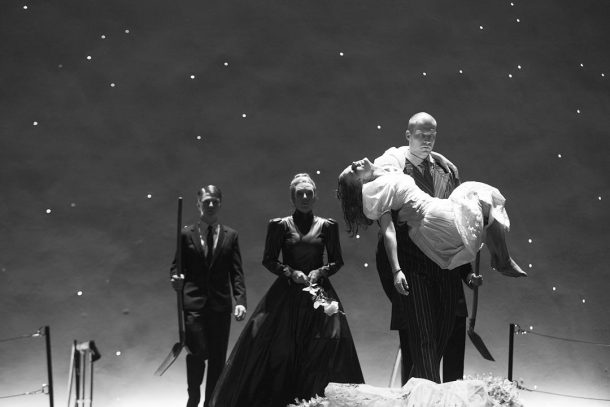
Shakespeare’s Hamlet. Photo: courtesy of Staatsschauspiel Dresden.
The wall with its boxes moves further upstage and slowly sinks out of sight, revealing a vast starry sky above a dark bare stage with Hamlet and Horatio near the proscenium. The Woods of Birnam group appears far upstage, in formal black garb and playing music suggesting that of a New Orleans jazz funeral. A much stranger figure then emerges far upstage, a bespangled torch singer with an elaborate feathered robe. Only her shovel identifies her as the gravedigger, but, handing her robe to Horatio and jumping into a grave, she is revealed as Ophelia, her naked legs still bearing the red crayon marks she put there during her mad scene. Neither Horatio nor Hamlet recognize her, but instead enter into her half-mad surrealistic universe, and she begins digging in the grave and shoveling out arcs not of dirt but of glittering spangles. Like the Ghost in Shakespeare’s original first act, she disappears from one grave and pops up, still shoveling in another across the stage. She does though provide Hamlet with a skull, which he uses again in a performative way, like a ventriloquist’s dummy. Her gravedigging finished, she goes upstage, where a funeral process is coming upward from some hidden depth. She falls into the arms of Laertes who brings her down to lay her out center stage. Polonius is laid beside her, but the procession then leaves as it came, and Hamlet plays the last scene alone, against a now starless sky. He props up the two corpses back to back to watch the scene as he takes each of the roles in turn and plays the final scene as a monodrama. At last he lies an isolated corpse, watched only by his two already dead observers.
The two Shakespeare productions in the current repertoire of the Berlin Schaubühne are Hamlet and Richard III, both directed by the theatre’s head, Thomas Ostermeier, and both starring the leading actor of this theatre, the much-awarded Lars Eidinger. The Hamlet production dates back to 2008, while the Richard III, which I saw for the first time this spring, was added in November of 2015. Although not in fact created in the Quadricentennial year, it has been the major Shakespeare production this year at the Schaubühne and toured to Craiova, Romania in April, Harbin and Tianjin in China in July, and to the Edinburgh Festival in August. The production is essentially a star turn for Eidinger, who is rarely absent from the stage and leads a small ensemble playing multiple roles. Indeed Richmond does not appear at all, and one of the most memorable sequences of the evening is the final battle, which, in a rather surprising parallel to Vontobel’s Hamlet in Dresden, is performed as a solo combat all over the multi-level stage by Eidinger, suggesting that his struggle is as much against internal foes as external ones.
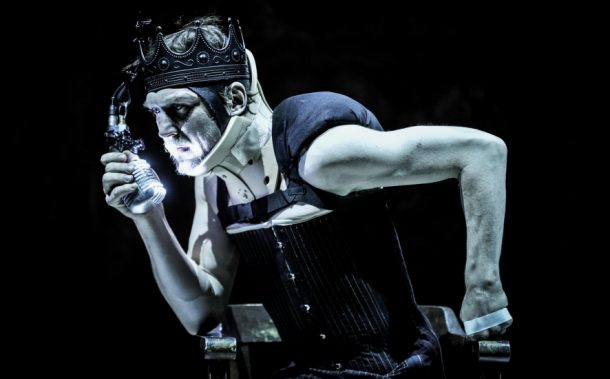
Lars Eidinger as Richard III in William Shakespeare’s Richard III, directed by Thomas Ostermeier. Photo: Carno Declair.
The setting, by Ostermeier’s usual designer Jan Pappelbaum, is far from the rather elaborate constructions of many previous Ostermeier works. A small stage at the Schaubühne, Saal C, normally used with a small raked audience facing a semi-circular concrete stage, has been completely refigured, to suggest Shakespeare’s Globe. The audience is now seated in three shallow tiers surrounding a new thrust stage backed by a high rough plaster wall, with dark wooden gantries and stairs crossing in and suggesting medieval ramparts. At the center is a tapestried entrance, suggesting the Shakespearian “inner below” through which most entrances are made, including occasional platforms with chairs, tables, and coffins.
The dominant scenic element, hanging from a crude and tangled wire center stage, is an old-fashioned mic, always present and always internally lit, with a live feed camera in it. From the very beginning this mic is essentially the property of Richard, who often will speak or sing into it while its harsh light illuminates his distorted features. Occasionally he will thrust the mic at another character such as Buckingham, when eliciting their response to a question, but the instrument is essentially his. A new dimension is added to its use in the latter part of the play, when its internal camera provides a close-up of his face, which is projected onto the darkened wall behind. When he lies in troubled sleep before the final battle, the ghosts cluster behind his bed and pass the mic among them, each appearing in turn as a spectral projection in the back wall as well as an illuminated face in the darkness below. At the conclusion, Richard, collapsed on this same bed center stage, thrusts one leg into the tangled mic cord and is slowly pulled upward to hang by that leg center stage, like a slaughtered animal, as the lights fade.
Although, as is normally the case in Ostermeier productions, the costumes (by Florence von Gerkin) are contemporary, there are (aside from the mic and, especially in the boisterous opening, a liberal use of glitter-bombs) none of the modern touches, such as cell phones, seen in other Ostermeier revivals. The dress tends toward the simple and somber, fitting the minimalist setting. There are also two striking scenes of male nudity, much more common on the German than on the Anglo-Saxon stage. Clarence is sleeping in the nude when surprised by his murderers and the thrashings of his nude body in a widening pool of blood (which like the glitter from the opening scene remains on the stage floor for the rest of the evening) are profoundly disturbing. Much more surprising is the almost total disrobing of Richard during the Lady Anne scene, so that he offers to her not only his naked breast but his full nakedness—or almost full, for although he removes all his clothing, and even a costumed club foot, he keeps his black hump, clearly a prop accessory strapped to his back.
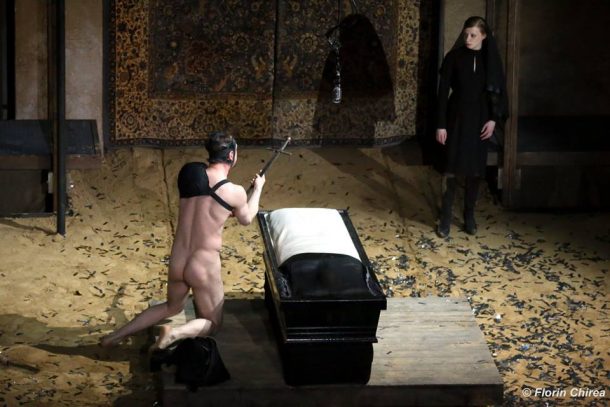
Shakespeare’s Richard III. Photo: Carno Declair.
This revelation, like the ever-present mic, reminds us of Richard the performer, an aspect strongly emphasized by Eidinger. Shakespeare’s Richard is one of the bard’s characters most inclined to address the audience (or himself) and Eidinger constantly develops this, addressing the audience at least as much as his fellow players, and sometimes breaking up himself when he stimulates laughter in them. The entire final section of the play is initiated with him sitting at table and smearing his face with some white concoction from his dish, suggesting perhaps a death mask, and perhaps a clown, both highly suitable to this final sequence.
Eidinger so dominates the production that the other nine company members, some of whom play several roles, are quite in his shadow, but special mention should be made of Moritz Gottwald, whose internal and cool Buckingham provides an excellent contrast in villainy to Eidinger’s flamboyant Richard, to Eva Meckbach as the long-suffering Elizabeth, and to long-time Schaubühne veteran Robert Beyer, whose masculine and sepulchral Margaret literally and figuratively hovers over the production.
The two princes are represented by bunraku-style puppets, one with three black-clad manipulators, the other with two, and although a small orchestra area is set aside to the right of the playing area, the musical accompaniment is provided by a single percussionist, Nils Ostendorf, and by an electronic score. Dim and colorless projections of nature often cover the rear wall, open skies with clouds and birds in the earlier part of the play, busy micro-organisms and indistinct swirling shapes later, but I found these far less effective than the electronic score or the projected faces, which much more clearly supported the dramatic action.
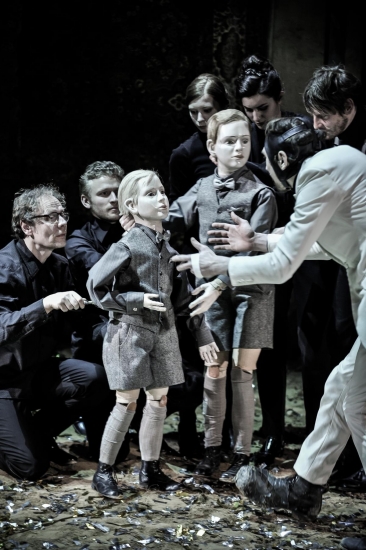
Shakespeare’s Richard III. Photo: Carno Declair.
Berlin’s other leading theatre, the Deutsches Theater, has three Shakespeares in its current repertoire, Twelfth Night, Macbeth, and Romeo and Juliet, though none were playing in May when I was there. I was able, however, to see the single Shakespeare now being shown at the Maxim Gorki, Othello, which was in fact a Quadricentennial premiere, on 19 February.
The Maxim Gorki is one of Berlin’s most interesting theatres today. In 2013 a new director was named, Shermin Langhoff, born in Turkey and a leader in the growing Turkish-German community. Her great success in presenting work based on the experience of this community at Berlin’s Ballhaus Naunynstrasse, work that she and colleagues gave the label “post-migrant theatre,” led to her appointment as head of the Gorki, and there she and her ethnically mixed company have continued a program of works primarily related to immigrant, post-migrant, ethnic, and postcolonial concerns. After her first season the leading journal Theater heute named the Gorki Theatre of the Year.
So far Langhoff has produced few standard classics at the Gorki, but Othello, concerned so centrally with the position of the racial outsider, is not at all a surprising choice for the first Shakespeare of the new administration. What is surprising is that the director, Christian Weise, has not made the production a more or less straightforward study of the tensions aroused by a prominent ethnic outsider, but has used Shakespeare’s basic plot to explore a very wide range of inter-related concerns, of the construction of gender and racial identity, of the social and cultural manipulation of members of a society, of imperial and postcolonial strategies of oppression and containment. The top of the program contains in large letters (far larger than those of the play title, its author, or its interpreters) Gayatri Spivak’s famous challenging question: “CAN THE SUBALTERN SPEAK?”
The physical interpretation of this Othello is even more unexpected than its wide range of contemporary political and social reflection. The entire production is presented in a flamboyant commedia dell’arte style. Othello (a dashingly handsome Taner Şahintürk) bears one of the least exaggerated costumes, but it is still clearly theatrical, a dark, swashbuckling leather frock with heavy buckles. He also wears little makeup, while the rest of the company is heavily made up, in a style close to that of conventional clowns. As a result Othello, despite a dashing black beard, presents the only visage on stage which can be read as conventionally “white.”
Othello is not the first to appear however. The production begins with two far more exaggerated figures in both makeup and costume: Brabantio (Falilou Seck) and Iago (Thomas Wodianka). Both are in heavy clown makeup—Iago the white clown—and both wear highly exaggerated Renaissance garb, with elaborate slashing and puffing (costumes by Andy Besuch), but they are sharply contrasted: Iago very thin, in green pastels with white puffing, and Brabantio hugely padded, in bright scarlet with white puffing. The two debate over who will control Othello’s fate, bringing us at once into a world of theatrical manipulation, and the defeated Brabantio retreats, rarely to be seen again.
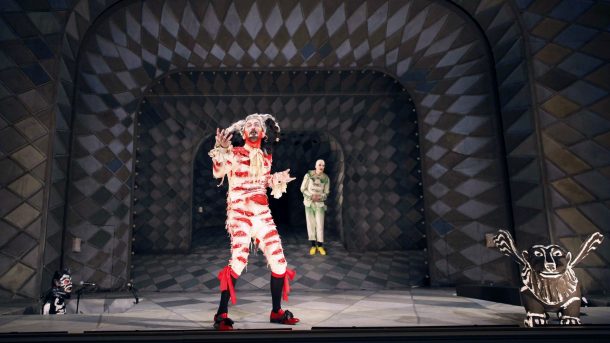
Othello by Soeren Voima after William Shakespeare, directed by Christian Weise. Photo: Ute Langkafel.
Designer Julia Oschatz has created a setting which, despite its apparent simplicity, admirably serves the theatricalized, even farcical, presentation. The audience enters to find a formal setting without scenic elements, composed only of three proscenium arches of diminishing size behind the normal one, and two grave-like openings, one on each side of the stage, one with a piano in it, indicating what is in fact the case, that these will normally contain musical accompanists. The repeated pattern of diamond shapes which is found on the walls of the Gorki is repeated on each of these interior arches, and the last one is filled by a wall in the same pattern in the middle of which, the center of the perspective, is a rectangular opening, perhaps four feet wide, in which hangs a simple black curtain. The stage area immediately in front of this opening is sharply tilted upward to increase the feeling of a visual perspective, just as was actually done on the Italian stages of the Renaissance, the same period which inspired the costumes. This dark opening, however, is used in a very modern way, both unconventional and yet perfectly suited to the physicality of the performance. Each major character, throughout the evening, makes his or her entrance coming on their back feet first out through this curtain and then tumbling down the raked stage area to end in a heap at the bottom. Their fall and final landing are accompanied, as is most of the action, by the whistles, percussive bumps, and cymbal clashes often associated with physical farce and provided in this case by figures in the two small pits on stage, each costumed and masked as skeletons.
For the most part this simple formal setting frames the action, although individual, rather cartoonish three-dimensional props are from time to time added to it, most notably a blockish black and white Lion of Venice the size of a small settee, which is used primarily as a podium which characters mount to present particular speeches. Othello and Desdemona also have a very funny scene in a similarly cartoonish three-dimensional black and white gondola which breaks into pieces when they try to ride off in it.
Although the action loosely follows Shakespeare’s original, the text, by Soeren Voima, is admittedly “after Shakespeare,” and few specific lines are retained from the original. All are updated, and there are extended interpolated monologues and dialogues dealing with the central concern of the production—the internal and external forces controlling the creation and maintenance of identity, including the identity of stage characters. Almost all the main characters are to a greater or lesser degree puppets of Iago (some, like Oscar Olivo as a cape and dagger Cassio, almost literally so), every movement of their head or limbs suggesting the mechanical movements of a manipulated doll.
When the action moves to Cyprus an important new element is introduced—that of institutionalized colonialism and its effects. This transition is signaled by one of several cartoon sequences projected over the entire front of the theatre, this one representing the defeat of the Turks, complete with rapidly moving child-like images of ships and fighting forces, of maps, waves and winds, all in the same sort of exuberant imaginative style of the production as a whole. These sequences are the work of Julia Oschatz.
In Cyprus, the upstage wall disappears on a turntable to reveal a deeper setting, mostly of dark scaffolding, levels and stairs. In front of it is grouped a chorus of eight Cypriot citizens, actually the entire company, even the two skeleton accompanists, but all now unrecognizable in shapeless robes and grotesque, distorted masks that have no resemblance to the commedia suggestions used elsewhere. Gathered in a group facing the audience, the chorus first complains of the use of their homeland as a mere pawn in the imperialist struggles between Turkey and Venice, a complaint which is then extended to address Spivak’s question, “Can the subaltern speak?” The Cypriots bemoan their silencing, by the play with its emphasis on the major characters representing other cultures, and by the fact that Shakespeare, and the interests of his audience, have no concern with hearing their voices. They are a chorus which is dramatically necessary to provide background for the action, but without agency, without even lines to speak.
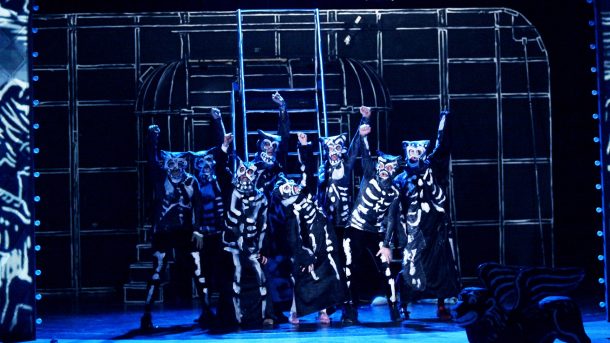
Voima’s Othello. Photo: Ute Langkafel.
Other dimensions of the arbitrary but powerful forces of generally accepted stereotypes are also explored, probably most strikingly in the case of the production’s two women, Desdemona (Aram Tafreshian) and Emilia (Falilou Seck).
Desdemona strikes an odd note from the beginning, so tall and thin that she towers over the not at all diminutive Othello, dressed in willowy revealing silks that belie her virginal reputation, and made up with accented eyes and huge arching eyebrows that give her a perpetually wondering air. When at last Othello removes her clothing and reveals her as a man, it is not a great surprise, but this is also the case for the actors. Desdemona simply tucks away her embarrassing penis between her legs and both accept the dramatic convention of gender as before.
The later part of the play departs further and further from the original to become more and more focused upon the force and yet the arbitrariness of both theatrical roles and cultural roles. The concern over jealousy is replaced by a concern over identity, especially on the part of Othello, torn between the desire to create an “authentic” self onstage and off, but forced by pre-existing prejudice, his own and others’, to play “safe” roles in both situations, thus reinforcing the existing order, internally and externally. Like the subaltern chorus he has no way of speaking this independent voice.
As Othello attempts to articulate this dilemma, the rest of the company moves in an increasingly robotic, puppet-like manner, each caught in their own mechanistic existence. Iago seizes Othello and for the first time applies to his face makeup like that of the others, blackening his cheeks under a golden mask. As a result, Desdemona sees him for the first time as an Arab other, and is overcome with revulsion. The established order has reaffirmed itself.
Marvin Carlson, Sidney E. Cohn Professor of Theatre at the City University of New York Graduate Center, is the author of many articles on theatrical theory and European theatre history, and dramatic literature. He is the 1994 recipient of the George Jean Nathan Award for dramatic criticism and the 1999 recipient of the American Society for Theatre Research Distinguished Scholar Award. His book The Haunted Stage: The Theatre as Memory Machine, which came out from University of Michigan Press in 2001, received the Callaway Prize. In 2005 he received an honorary doctorate from the University of Athens. His most recent book is The Theatres of Morocco, Algeria and Tunisia with Khalid Amine (Palgrave, 2012).
European Stages, vol. 7, no. 1 (Fall 2016, Special Issue: Shakespeare in Europe, 2016)
Editorial Board:
Marvin Carlson, Senior Editor, Founder
Krystyna Illakowicz, Co-Editor
Dominika Laster, Co-Editor
Kalina Stefanova, Co-Editor
Editorial Staff:
Cory Tamler, Managing Editor
Mayurakshi Sen, Editorial Assistant
Advisory Board:
Joshua Abrams
Christopher Balme
Maria Delgado
Allen Kuharsky
Bryce Lease
Jennifer Parker-Starbuck
Magda Romańska
Laurence Senelick
Daniele Vianello
Phyllis Zatlin
Table of Contents:
- Some Quadricentennial Shakespeare in Germany by Marvin Carlson
- Tiago Rodrigues’s Antony and Cleopatra by Manuel García Martínez
- Amleto: An Opera Rediscovered by Katrin Hilbe
- Coping With the Greatest for Over One Hundred Years by Alen Biskupović
- The Art of Sharing Shakespeare: Emil Boroghină, a Romanian Sorcerer by Maria Zărnescu
- Shakespeare’s Villains and Modern Politicians in Latvia by Edīte Tišheizere
- A Queen for a King! Tom Lanoye’s Königin Lear at Schauspiel Frankfurt by Katrin Hilbe
- The Tempest: Magical Ballet Where East Meets West by Sepideh Shokri Poori
- “The Ukrainian Play”: Macbeth Ritualized by Vlad Troitskyi by Daria Moskvitina
- Les Kurbas’s Tradition in Ukrainian Shakespeare Productions by Nataliya Torkut
Martin E. Segal Theatre Center:
Frank Hentschker, Executive Director
Marvin Carlson, Director of Publications
Rebecca Sheahan, Managing Director
©2016 by Martin E. Segal Theatre Center
The Graduate Center CUNY Graduate Center
365 Fifth Avenue
New York NY 10016



